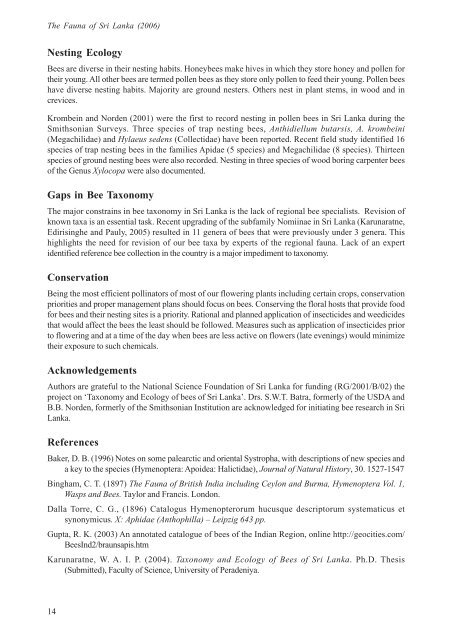The Fauna of Sri Lanka - IUCN
The Fauna of Sri Lanka - IUCN
The Fauna of Sri Lanka - IUCN
Create successful ePaper yourself
Turn your PDF publications into a flip-book with our unique Google optimized e-Paper software.
<strong>The</strong> <strong>Fauna</strong> <strong>of</strong> <strong>Sri</strong> <strong>Lanka</strong> (2006)<br />
Nesting Ecology<br />
Bees are diverse in their nesting habits. Honeybees make hives in which they store honey and pollen for<br />
their young. All other bees are termed pollen bees as they store only pollen to feed their young. Pollen bees<br />
have diverse nesting habits. Majority are ground nesters. Others nest in plant stems, in wood and in<br />
crevices.<br />
Krombein and Norden (2001) were the first to record nesting in pollen bees in <strong>Sri</strong> <strong>Lanka</strong> during the<br />
Smithsonian Surveys. Three species <strong>of</strong> trap nesting bees, Anthidiellum butarsis, A. krombeini<br />
(Megachilidae) and Hylaeus sedens (Collectidae) have been reported. Recent field study identified 16<br />
species <strong>of</strong> trap nesting bees in the families Apidae (5 species) and Megachilidae (8 species). Thirteen<br />
species <strong>of</strong> ground nesting bees were also recorded. Nesting in three species <strong>of</strong> wood boring carpenter bees<br />
<strong>of</strong> the Genus Xylocopa were also documented.<br />
Gaps in Bee Taxonomy<br />
<strong>The</strong> major constrains in bee taxonomy in <strong>Sri</strong> <strong>Lanka</strong> is the lack <strong>of</strong> regional bee specialists. Revision <strong>of</strong><br />
known taxa is an essential task. Recent upgrading <strong>of</strong> the subfamily Nomiinae in <strong>Sri</strong> <strong>Lanka</strong> (Karunaratne,<br />
Edirisinghe and Pauly, 2005) resulted in 11 genera <strong>of</strong> bees that were previously under 3 genera. This<br />
highlights the need for revision <strong>of</strong> our bee taxa by experts <strong>of</strong> the regional fauna. Lack <strong>of</strong> an expert<br />
identified reference bee collection in the country is a major impediment to taxonomy.<br />
Conservation<br />
Being the most efficient pollinators <strong>of</strong> most <strong>of</strong> our flowering plants including certain crops, conservation<br />
priorities and proper management plans should focus on bees. Conserving the floral hosts that provide food<br />
for bees and their nesting sites is a priority. Rational and planned application <strong>of</strong> insecticides and weedicides<br />
that would affect the bees the least should be followed. Measures such as application <strong>of</strong> insecticides prior<br />
to flowering and at a time <strong>of</strong> the day when bees are less active on flowers (late evenings) would minimize<br />
their exposure to such chemicals.<br />
Acknowledgements<br />
Authors are grateful to the National Science Foundation <strong>of</strong> <strong>Sri</strong> <strong>Lanka</strong> for funding (RG/2001/B/02) the<br />
project on ‘Taxonomy and Ecology <strong>of</strong> bees <strong>of</strong> <strong>Sri</strong> <strong>Lanka</strong>’. Drs. S.W.T. Batra, formerly <strong>of</strong> the USDA and<br />
B.B. Norden, formerly <strong>of</strong> the Smithsonian Institution are acknowledged for initiating bee research in <strong>Sri</strong><br />
<strong>Lanka</strong>.<br />
References<br />
Baker, D. B. (1996) Notes on some palearctic and oriental Systropha, with descriptions <strong>of</strong> new species and<br />
a key to the species (Hymenoptera: Apoidea: Halictidae), Journal <strong>of</strong> Natural History, 30. 1527-1547<br />
Bingham, C. T. (1897) <strong>The</strong> <strong>Fauna</strong> <strong>of</strong> British India including Ceylon and Burma, Hymenoptera Vol. 1,<br />
Wasps and Bees. Taylor and Francis. London.<br />
Dalla Torre, C. G., (1896) Catalogus Hymenopterorum hucusque descriptorum systematicus et<br />
synonymicus. X: Aphidae (Anthophilla) – Leipzig 643 pp.<br />
Gupta, R. K. (2003) An annotated catalogue <strong>of</strong> bees <strong>of</strong> the Indian Region, online http://geocities.com/<br />
BeesInd2/braunsapis.htm<br />
Karunaratne, W. A. I. P. (2004). Taxonomy and Ecology <strong>of</strong> Bees <strong>of</strong> <strong>Sri</strong> <strong>Lanka</strong>. Ph.D. <strong>The</strong>sis<br />
(Submitted), Faculty <strong>of</strong> Science, University <strong>of</strong> Peradeniya.<br />
14

















